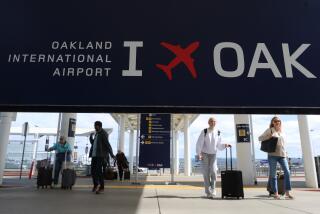Rivals Covet Airport Slots
- Share via
The vultures are circling over the airports in Los Angeles and San Francisco.
Although United Airlines hasn’t yet filed for bankruptcy court protection, competitors are wasting no time talking to California’s largest airports about moving into terminal space the airline might vacate in a restructuring.
The specter of a bankruptcy filing by United parent UAL Corp. also has prompted the major credit-rating services to review the debt carried by Los Angeles International and San Francisco International airports.
United, the nation’s second-largest airline, behind American, is the biggest operator at LAX and San Francisco. It accounts for about one out of every six air transportation jobs in the Golden State, and more than a quarter of its 1,800 daily departures originate from a California airport.
Money-losing United has said failure to win a $1.8-billion federal loan guarantee Wednesday probably will push it into Bankruptcy Court, where it would seek protection from its creditors.
United has nearly 23,000 employees in California, more than a quarter of its 82,700 workers worldwide. The airline already has said it plans to trim flights by 6% next year and slash employment by 9,000 workers by 2004, which could mean 3,000 California jobs lost. A bankruptcy filing probably would precipitate greater cuts in staff and service, according to analysts and people within the airline.
No filing has been made. Yet rival airlines already are inquiring about picking up airport gates and routes at San Francisco. Michael McCarron, an airport spokesman, said the discussions were preliminary and confidential. San Francisco, where United controls 25 of the 90 gates, is an important domestic and international hub for the airline.
LAX spokesman Paul Haney said the airport has had what he characterized as “informal inquiries” from airlines looking to pick up some of United’s 27 gates and terminal space. United controls 17% of LAX’s gates.
None of the major airlines would confirm holding talks with either airport. Terminal space at major airports is a coveted asset, and if United winds up reducing operations in a Chapter 11 reorganization, as expected, it probably would have to give up some of its gates.
As long as the airports were able to replace United’s business with other airlines’ passengers, the facilities would not see much of a reduction in their revenues. And analysts say a United bankruptcy filing would not put the two airports in any immediate financial danger because the carrier is current in its lease payments and landing fees.
United pays LAX about $39 million annually, which represents 8.3% of the airport’s $470.9-million budget. The airline pays San Francisco International much more: $9.4 million a month in rent and landing fees. That’s 28% of the airport’s revenue.
Both airports, however, still have investment-grade credit ratings and could withstand a modest downgrade, analysts said.
It’s important for airports to maintain positive ratings because they rely on borrowing to fund capital improvements.
Right now, LAX has the highest credit rating of any airport, according to Fitch Ratings and Standard & Poor’s. But Fitch issued a negative outlook for the facility Thursday because of uncertainty over United’s fate in particular and the poor operations of the airline industry in general.
The agency put San Francisco’s airport on a negative ratings watch -- a more severe warning of a potential downgrade -- because of its greater exposure to United’s troubles.
United accounts for about 50% of the traffic in San Francisco but just under 18% at Los Angeles International.
San Francisco International “has limited flexibility to handle further service level disruptions by United,” S&P; said when it issued a negative outlook on the airport’s debt this week.
Not only is United the dominant airline at San Francisco International, offering 160 domestic and international departures daily, but the airport also is home to the carrier’s West Coast maintenance facility, a sprawling bay-side complex that employs about 5,000 workers.
Additionally, San Francisco International has seen its fixed costs rise sharply and passenger traffic plunge 20% since last year’s terrorist attacks upended the airline industry, Fitch Ratings said.
The decline in traffic has cut into parking fees, duty-free sales and concession revenue, a trend that could worsen if United sheds flights at the airport.
Fitch projects that San Francisco’s operating cost per passenger will reach $19.99 in the 2003 fiscal year, higher than at most comparable U.S. airports.
By comparison, an analysis of LAX’s operations for the rating services placed its current cost per passenger at $5.70.
In a worst-case scenario -- in which United goes out of business and its traffic is not replaced -- LAX’s cost per passenger would rise to only $7.46, still at the low end for most major airports. United has 113 daily departures from LAX.
More to Read
Inside the business of entertainment
The Wide Shot brings you news, analysis and insights on everything from streaming wars to production — and what it all means for the future.
You may occasionally receive promotional content from the Los Angeles Times.











